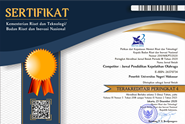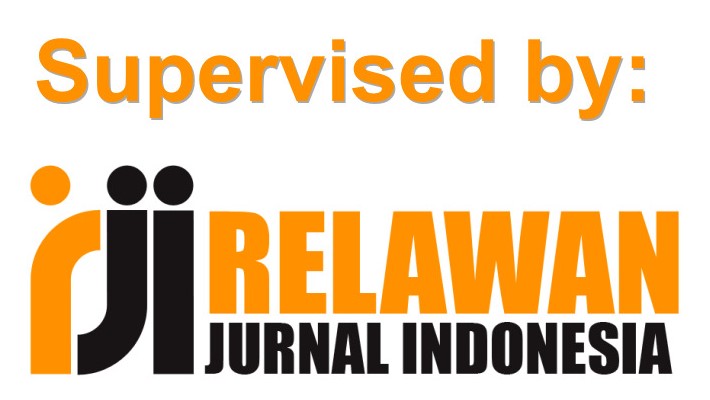The Effect of Training Model and Tennis Skill Level on Concentration and Groundstroke Skills in Tennis Athletes
(1) Universitas Pendidikan Indonesia
(2) Universitas Pendidikan Indonesia
(3) Universitas Pendidikan Indonesia
(*) Corresponding Author
DOI: https://doi.org/10.26858/cjpko.v13i3.24775
Abstract
Keywords
Full Text:
PDFReferences
Aksenov, D. P., Dmitriev, A. V, Miller, M. J., Wyrwicz, A. M., & Linsenmeier, R. A. (2018). Neuropharmacology Brain tissue oxygen regulation in awake and anesthetized neonates. Neuropharmacology, 135, 368–375. https://doi.org/10.1016/j.neuropharm.2018.03.030
Amni, Hazrin., Sulaiman, Iman., & Hernawan. (2019). Model Latihan Keterampilan Groundstroke Pada Cabang Olahraga Tenis Lapangan. Jurnal Terapan Ilmu Keolahragaan. Vol 4 No 2 Tahun 2019 (91-98).
Andrianopoulos, V., Vogiatzis, I., Gloeckl, R., Bals, R., Koczulla, R. A., & Kenn, K. (2018). Respiratory Physiology & Neurobiology Cerebral oxygen availability during exercise in COPD patients with cognitive impairment. Respiratory Physiology & Neurobiology, 254(April), 64–72. https://doi.org/10.1016/j.resp.2018.05.001
Asan, R. (2011). Sekiz haftalık masa tenisi egzersizinin 9-13 yaş arası çocuklarda dikkat üzerine etkisi (Doctoral dissertation, Selçuk Üniversitesi Sağlık Bilimleri Enstitüsü.
Bereket, Yücel, S., Erkut O., Duru A.D., Bozkurt S. (2016). Effects of a sedentary lifestyle, gymnastics, and team sports training on anthropometric parameters, visual selective attention and coincidence anticipation time of 7-9 years old boys visual selective attention and coincidence anticipation time of 7-9 years old boys. Global forum. Hacettepe University Ankara, Turkey.
Bompa, T. O., & Haff, G. (2009). Periodization: Theory and methodology of training. Human Kinetics.
Bourquin O. Coordination., In M Crespo., M Reid., & D Miley. (2003). Applied sports science for high-performance tennis. The International Tennis Federation, ITF Ltd, 49-51; 2003.
Borysiuk, Z., & Waskiewicz, Z. (2008). Information processes, stimulation, and perceptual training in fencing. Journal of Human Kinetics; 19: 63-82.
Brown, J. (2001). Tenis Tingkat Pemula. Jakarta: PT. Raja Grafindo Persada.
Chun, M. M., & Turk-browne, N. B. (2007). Interactions between attention and memory. https://doi.org/10.1016/j.conb.2007.03.005
Delgado, M. R., Phelps, E. A., & Robbins, T. W. (Eds.). (2011). Decision making, affect, and learning: Attention and performance XXIII (Vol. 23). Oxford University Press. https://booksdescr.com/item/adv/784514
Gallahue, D. L., Ozmun, J. C., & Goodway, J. (2006). Understanding motor development: Infants, children, adolescents, adults. Boston.
Gillmeister, Heiner. (2017) Tennis: A Cultural History (2nd ed.). Journal of sport history
Hai-li, Z., Hai-jun, Z., & Xiao-tao, G. (2018). ScienceDirect Experimental study on Taijiquan exercises improving university students ’ cognitive function. Cognitive Systems Research, 52, 591–595. https://doi.org/10.1016/j.cogsys.2018.08.007
Hidayat, Yusuf. (2017). Pengantar Psikologi Olahraga. CV. Bintang Warli Artika. Bandung.
ITF. (2015). Rules of Tennis. Roehampton: London.
Jensen, A. R., & Robert, A. (1998.). The Science of Mental Ability. http://dx.doi.org/10.1037/h0095874
Komarudin. (2015). Psikologi Olahraga. PT Remaja Rosda Karya. Bandung.
Kovtanyuk, A. E., Chebotarev, A. Y., Botkin, N. D., Turova, L., Sidorenko, I. N., & Lampe, R. (2019). A continuum model of oxygen transport in the brain. Journal of Mathematical Analysis and Applications, (October 2018). https://doi.org/10.1016/j.jmaa.2019.02.020
Kwon, S., Pfister, R., Hager, R. L., Hunter, I., & Seeley, M. K. (2017). Influence Of Tennis Racquet Kinematics On Ball Topspin Angular Velocity And Accuracy During The Forehand Groundstroke. Journal Sport & Medicine. https://www.ncbi.nlm.nih.gov/pmc/articles/PMC5721180/
Lardner, R. (2003). Pedoman Lengkap Bermain Tenis. Semarang: Dahara Prize.
Laurence PC. (2000). The role of rhythm in ballet training. Research in Dance Education, 1: 173-191.
Liu, S., & Yuan, C. (2005). Applying The Technology Acceptance Model And Flow Theory To Online E-Learning Users ’ Acceptance Behavior.
Loman, L. (2008). Petunjuk Praktis Bermain Tenis. Bandung: Angkasa.
Moran, A. (2017). Attention and Concentration Training in Sport, (October 2015), 1–5. https://doi.org/10.1016/B978-0-12-809324-5.05476-6
Palmizal A. (2011). Pengaruh Metode Latihan Global terhadap Akurasi Ground Stroke Forehand dalam Permainan Tenis. Jurnal Media Ilmu Keolahragaan Indonesia. Volume 1. Edisi 2. ISSN: 2088-6802. http://journal.unnes.ac.id/index.php/miki
Paulson, O. B., Hasselbalch, S. G., Rostrup, E., & Knudsen, G. M. (2009). Cerebral blood flow response to functional activation. Journal of Cerebral Blood Flow & Metabolism, 30(1), 2–14. https://doi.org/10.1038/jcbfm.2009.188
Prasetiono, B. A., & Gandasari, M. F. (2018). Model Rangkaian Tes Keterampilan Tenis Lapangan Pada Pemain Putra Kelompok Usia 12-14. Jurnal SPORTIF : Jurnal Penelitian Pembelajaran http://ojs.unpkediri.ac.id/index.php/pjk
Reid M, Chow JW, Crespo M. (2003). Muscle activity: An indicator for training. In B Elliot, M Reid, M Crespo (Eds.). ITF biomechanics of advanced tennis. The International Tennis Federation, ITF Ltd, 111-136.
Rosriza, A. Pengembangan Model Pembelajaran Voli Forehand Tenis Lapangan. Jurnal Paedagogik Keolahragaan, 01, 20-28.
Sakai, K., Hikosaka, O., & Nakamura, K. (2004). The emergence of rhythm during motor learning. Trends in cognitive sciences, 8(12), 547-553.
Schönborn R. (2003). Timing in tennis: New findings and conclusions. In M Crespo, M Reid, D Miley (Eds.). Applied sports science for high-performance tennis. The International Tennis Federation, ITF Ltd, 37-39.
Segal DK. (2005). Tennis biodynamic system: For the teaching and correction of tennis shots. Destino Global Sports Marketing: Buenos Aires,.
Siahaan, David. (2019). Pengaruh Latihan Bandul Stroke With Feeding Terhadap Kemampuan Groundstroke Tennis. JSCE : Jurnal Ilmiah Sport Coaching and Education. https://doi.org/10.21009/JSCE.03111
Söğüt, Mustafa., Kirazci, Sadettin., & Korkusuz, Feza. (2012). The Effects of Rhythm Training on Tennis Performance. Journal of Human Kinetics volume 33/2012, 123-132. http://DOI: 10.2478/v10078-012-0051-3
Sukadiyanto. (2005). Jurnal Olahraga Prestasi Prinsip-Prinsip Pola Bermain Tenis Lapangan. Yogyakarta: Universitas Negeri Yogyakarta.
Takahata, M., Shiraki, K., Sakane, Y., & Takebayashi, Y. (2004). Sound feedback for powerful karate training. In Proceedings of the 2004 conference on New interfaces for musical expression (pp. 13-18). The National University of Singapore.)
Tanır, Ayşe., & Erkut, Oya. (2018). Effect of Rhythmic Basketball Lessons on Visual Attention Ability and Lay-up Skill in School Children Aged 9-10. Universal Journal of Educational Research 6(9): 1857-1862. DOI: 10.13189/ujer.2018.060901.
Thaut MH. (2005). Rhythm, music, and the brain: Scientific foundation and clinical application. Routledge. New York.
Toner, J., & Moran, A. (2014). In praise of conscious awareness: a new framework for the investigation of ‘continuous improvement’ in athletes. Frontiers in Psychology: Cognition, 5, 769.
Verbruggen, F., McLaren, I. P. L., & Chambers, C. D. (2014). Banishing the control homunculi in studies of action control and behavior change. Perspectives on Psychological Science, 9, 497-524.
Wilson, V. E., Peper, E., & Schmid, A. (2006). Training Strategies for Concentration. https://www.researchgate.net/publication/292712022_ Training_strategies_for_concentration
Wilson, Vietta E., Peper, Erik., & Schmid, Andrea. (2006). Training Strategies for Concentration. Research Gate. https://www.researchgate.net/publication/292712022
Yelin, E. H., & Sidney, S. (2010). COPD and cognitive impairment: the role of hypoxemia and oxygen therapy, (May). https://doi.org/10.1164/ajrccm-conference.2010.181.1
Zachopoulou E, Mantis K, Serbezis V, Teodosiou A, Papadimitriou K. (2000) Differentiation of parameters for rhythmic ability among young tennis players, basketball players, and swimmers. European Journal of Physical Education, 5: 220-230.
Zachopoulou E, Derri V, Chatzopoulos D, Ellinoudis T. (2003). Application of Orff and Dalcroze activities in preschool children: Do they affect the level of rhythmic ability? Physical Educator, 60: 50-56.
Zachopoulou, E., Tsapakidou, A., Derri, V. (2003).The effects of a developmentally appropriate music and movement program on motor performance. Early Childhood Research Quarterly, 19, 631-642.
Article Metrics
Abstract view : 229 times | PDF view : 54 timesRefbacks
- There are currently no refbacks.
Copyright (c) 2021 Rendy Aditya Cahyadi, Amung Mu'mun, Dian Budiana

This work is licensed under a Creative Commons Attribution 4.0 International License.
COMPETITOR IS LICENSED BY :
 COMPETITOR is licensed under a Creative Commons Attribution 4.0 International License.
COMPETITOR is licensed under a Creative Commons Attribution 4.0 International License.
COMPETITOR EDITORIAL LOCATION :
![]() Kampus FIK Banta Bantaeng, Jalan Wijaya Kusuma Nomor 14, Rappocini, Makassar, Postal Code 90222
Kampus FIK Banta Bantaeng, Jalan Wijaya Kusuma Nomor 14, Rappocini, Makassar, Postal Code 90222
COMPETITOR IS INDEXED BY















